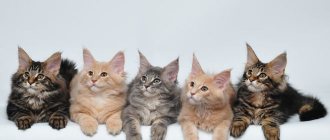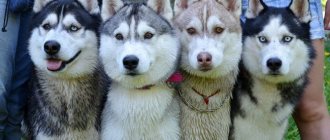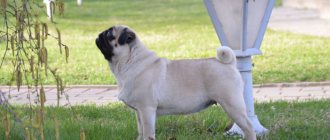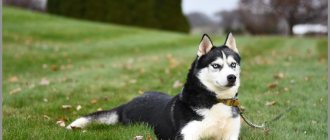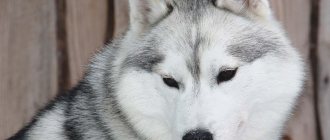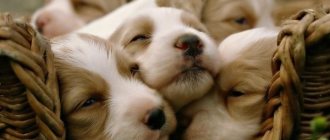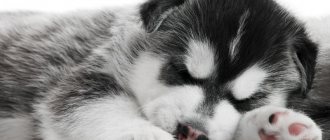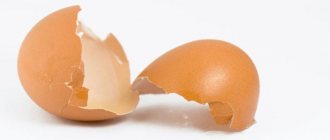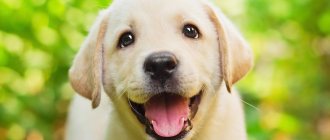Siberian Huskies have long ceased to be just sled dogs. They are distinguished by their calm and calm character, endurance, and kind attitude towards others, which is why dog breeders all over the world adopt charming puppies with blue eyes. Few people know which husky colors correspond to the standard, and which color is classified as a breed defect. Before you buy a cute little cat, it’s worth getting to know the most common color options for its coat.
What is the reason for the variety of colors?
Husky was bred by the peoples of the Far North based on local dogs and wolves. Selection for many centuries was carried out on the principle of selecting the most hardy and efficient individuals that can easily withstand harsh climatic conditions. They not only have to run in a harness, but also sleep in the snow. That is why minimal attention was paid to appearance, and the closest attention was paid to working qualities and health. This is how huskies of different colors appeared.
According to the standard approved by the IFF, the color can be anything from white to black. Different colors in all possible combinations, marks on the body or their complete absence are acceptable.
In the Russian Federation, the approach to this issue is more conservative - white color or its combination with black, gray or brown is considered the standard. But the rest of the colors are not considered a marriage, especially since Khasenys have such individual colors that it is extremely difficult to find two absolutely identical puppies.
Description of the breed
medium-sized sled dog , distinguished by endurance, good speed qualities and the ability to navigate the terrain well.
Bred by tribes inhabiting the northern part of the Far Eastern region of Russia in ancient times, the breed developed and improved under harsh weather conditions and almost natural selection, since human intervention in the selection of pairs was insignificant.
Being left to their own devices in the warm season, sled dogs were forced to get their own food , thanks to which they developed a hunting instinct, which modern representatives of this breed have inherited.
Since in those tribes it was not customary to divide property and territory into theirs and someone else’s, people did not need sled dogs to have guarding or protective qualities.
NOTE!
The modern husky has a friendly and affable character, he is active and playful, although sometimes he is prone to mischief.
These dogs' inherent loyalty to their owners, love of children and ability to adapt make them suitable as family pets.
However, you need to take into account that training a husky may not be such a simple matter, since these dogs are very freedom-loving and independent, and if something does not suit them, they can become stubborn and stop obeying their owner.
Common Siberian Husky Colors
There is no clear classification of husky colors. Dogs differ in the location of spots, markings, facial mask, eye and nose color.
World dog experts distinguish not four (as in the Russian Federation) color variations, but about twenty. The most common among them:
- brown;
- gray;
- chocolate;
- fawn;
- silver
Brown
Another name for brown color according to the standard is red. Hasyats are often born with red tops and white bottoms. In summer, under the bright sun, the coat fades a little, turns pale and the tone becomes less saturated. During this period, huskies are more beige than brown, and they are called yellow, which is a mistake. The eyes, which have several color variations, give the animals a special charm and uniqueness. Brown dogs with blue eyes and dark “glasses” around them look especially impressive. Over time, they can disappear, turning into a slightly noticeable outline.
Very often, newly born Khasenys have a rich fiery color. After the first molt, the puppies change color and turn into a white dog with light brown spots.
Gray (wolf)
The gray color is called wolf because of its similarity to the color of predators. In addition to the main color, it contains small inclusions of red and fawn. The spots are most noticeable behind the ears, on the neck, thighs, legs and hocks. The undercoat of gray hasenies is beige, the rims of the eyes, lips and nose are black.
Very often, gray-white cats with blue eyes are born. The shade of the coat can be either light or dark, the undercoat can be gray, cream or beige. If the coat is silver, the undercoat is white, as is the belly and paws. The mask on the face and the upper back are gray. Hasyats with wolf coloring have brown, multi-colored or blue eyes.
Chocolate
The richness of the chocolate color of the coat varies - from light cream to dark brown. Copper-colored dogs, which are lighter and brighter than chocolate, look most impressive. In combination with blue eyes, the suit looks amazing. Eye rims, nose, lips should be brown. More often, white-chocolate hasyats are born - with a light bottom, a darker back, brown, blue or different eyes.
Pale yellow
The fawn color is close in tone to red, but not as rich, more subdued. A noble pastel shade reminiscent of cream or beige. The pigmentation of the rims of the eyes, lips and nose is brown.
If the chicks are born fawn-white, the top of the body is initially brighter. Over time, the shade fades and differs very little from the main color.
Silver
The most striking of the light husky colors is silver. In the sun, the coat shimmers due to the combination of the white background of the undercoat and the shiny gray guard.
In silver-white huskies, the mask is clearly expressed, as is the “arrow” on the forehead. Such Khasenys are characterized by dark eye rims and a bright blue iris. Another name for the silver color is “silver”.
Grooming and hygiene
Huskies have a smooth, thick coat and a soft, fluffy undercoat. Once a week, your pet needs to be brushed. First, go over the wool with a slicker brush. Movements should be careful and smooth so as not to damage the coat. Then you can go over the top with a long-toothed comb.
Molting occurs 2 times a year. During this period, the pet needs to be combed daily.
The coat of puppies is formed before 6 months of age. To avoid damaging the coat, the puppy should be brushed with a gentle, soft brush.
Until the age of three months, the puppy cannot be bathed. Baby's skin is sensitive to chemicals.
An adult dog is bathed 2-3 times a year. You shouldn't do this more often. The skin is covered with a protective layer, which is washed off with shampoo. Because of this, your pet may experience skin irritation.
A special shampoo is required for bathing. The pet needs to be wet and soaped. Be careful not to get soap into your eyes or ears. Rinse off the foam with warm, clean water. Afterwards, dry the dog with a towel and dry it with a hairdryer.
This is interesting! Huskies have practically no smell. This breed is perfect for those who cannot stand the dog smell.
- Don't forget about the eyes. Once a week they need to be wiped with a cloth moistened with clean water.
- Clean your ears once a week using cotton swabs.
- Brush your teeth once a month with a special brush and tooth powder.
Huskies are active and need long walks, so their nails must wear down on their own. But if this does not happen, the tips of the nails should be trimmed using a special nail clipper or ordinary nippers.
Thus, northern huskies delight dog breeders with a variety of colors. Some of them are more suitable for exhibitions, others are valued in sports.
The most striking feature of the breed is the mask, which can be found in almost all colors. It gives the muzzle a meaningful and unusual expression. And gray dogs are almost indistinguishable from wolves.
Rare husky colors
The most common color is gray. A white dog with blue eyes is not common, as are the rare husky colors presented in the table:
| Color | Description |
| White | Another name is snowy. Dogs have white not only guard hair, but also undercoat. Eyes are light brown, blue or different. |
| Soboliny (sable) | Sable Khasenysh with a bright copper undercoat. The spine is gradient - the color at the base is beige, and at the end it is dark gray, black-brown. The lips and eye rims are black. The nose may be brown. |
| Piebald | Piebald or spotted coloring involves a white background, occupying at least 70% of the husky's coat, and colored markings. They are of different shapes (round, asymmetrical) and colors (from red to black). Another name for the piebald color is pibold. |
| Black | There are no completely black huskies. Lighter markings are required on the legs, tail, and chest. If the pure charcoal color is at least 75%, the dog is classified as black or called an Afro Husky. |
| Black and white | In black and white, the percentage of the two colors is approximately the same. Dark back, main part of tail, outer side of ears. White muzzle with a mark on the forehead and paws. |
| Splash coat | Splash Coat Husky and Peebold are often confused. This is no coincidence. Both are black and white, with blue eyes, only the number and shape of the markings are different. Their arrangement in splash coats is often called “coat and cap”. The main difference is that there is more white than black and there is a light ring on the neck. |
| Tricolor | The background is black, and the muzzle, paws and chest are snow-white. A distinctive feature of the tricolor is the red markings near the eyes, on the body and limbs. The husky's undercoat can be yellow, peach or orange. |
| Marble | Rare huskies with a black muzzle, back, tail and hips, a random arrangement of spots on a light background. Markings of gray color of varying intensity. Eye rims, nose and lips are black. |
| Isabella | The dog has white fur with a fawn-colored awn. Eyes, nose, mucous membranes are brown. |
| Agouti | A rare color in which the hairs come in three shades at once - white, black and red. In combination with blue eyes, the husky looks menacing and unusual. |
| Cheprachny | A special feature of the saddle coat color is a dark saddle-shaped spot on the back. The mark, located on a snow-white background, can be of all types of colors - red, chocolate, gray and others. |
Bottom line
A wide range of colors and patterns are very popular in the Siberian Husky, so there are no true rare colors or patterns. The rare color of the Siberian Husky is most likely white, while the most unusual pattern seems to be piebald.
We hope you enjoyed reading our brief overview of the wide range of colors available in the Siberian Husky. Many of them are quite distracting. If we've taught you anything new and increased your love for these fascinating animals, please share this complete review of Husky colors on social media.
Husky color features
The individuality of each Khasenysh is determined by the special expression of the muzzle, depending on the shade of the iris, nose and lips. What makes a dog unique is the shape and color of the mask on its face. Some puppies immediately look menacing, while others are cute and good-natured even as adults.
Nose
The shade of the nose depends on the color of the dog:
- Black - for pure black, gray, silver and brown.
- Brown – in chocolate, piebald and isabella.
- Pink or flesh-colored - white ones have it.
- Snowy - dark with brown spots, found in variegated colors.
If the nose is partially depigmented, it is considered a fault.
Eyes
The eyes of Siberian sled dogs are very expressive due to the bright colors of the iris, which can be:
- Blue - the shade remains unchanged throughout life.
- Brown is so rich that it is often mistaken for black.
- Amber is a light shade of brown, found in red, snow and chocolate specimens.
- Heterochromia – different eyes (blue combined with amber or brown).
- Interspersed with brown spots on the blue iris.
- Split – the iris is divided into two halves of different colors.
Black and tan huskies with blue eyes, white and brown and many others look very impressive. The more unusual the eye color, the higher the price of a puppy.
"Mask"
For hasyats of any color, a characteristic feature is the presence of a “mask” on the face. It has clear boundaries, light or dark, and forms patterns of different shapes and types:
- shamrock;
- wolf;
- with a stripe on the bridge of the nose;
- heart;
- glasses;
- open;
- with eyebrows.
When do puppies open their eyes after birth?
Husky puppies are born blind. Their eyelids are underdeveloped. At first, the baby focuses on hearing, and the mother takes care of him.
Babies begin to open their eyes 10-14 days after birth. Most often, both eyes open at once. But it happens that one is late for a couple of days - this is considered the norm.
All puppies develop differently, so a slight delay is not a reason to panic.
If the baby is still blind at 18-20 days from birth, the husky's eyes should be rinsed with clean water. Inflammation or redness indicates health problems for your pet. The baby needs to be shown to a specialist.
Important! If your puppy is 30 days old and his eyes are still not open, you should consult a doctor.
Splash coat
Often the splash coat color is confused with the classic pebold color or they are considered to be one and the same.
Husky in a “coat” and “hat” - splash coat color
The opinion is erroneous, since the main difference in the shade of splash wool is the presence of a unique light ring located around the animal’s neck, like a collar.
Red Husky Splash Coat
The main color is white, the “coat” is dark or bright.
Marble
This color is characterized by uneven coloring of the coat and mixing of light and dark areas.
Marbled husky puppy
The base color is usually white, with randomly colored dark gray, light gray or black on the face, back, hips, and tail. Black eye rim.
Marble HuskyPinto Husky
This animal's fur looks very fancy and immediately attracts the eye .
Sable
The coat color is unusually beautiful and is rare.
The main shade is brown, red, copper-chocolate.
Sable Husky
The undercoat is usually light brown in color, the upper edge of the hairs is gray or black.
Husky dog sable color
The fur on the face may look like a black “mask”.
Origin story and what it looks like in the photo
The first sled dogs appeared in the Russian Far East back in the Neolithic era, where they were bred by aboriginal tribes belonging to the so-called “Okhotsk culture”.
It was from these dogs that the Chukchi sled dog originated, which in turn is the ancestor of such breeds as the Malamute, Samoyed and, of course, the Siberian Husky.
The appearance of these dogs was associated with the need to find new territories for hunting, which was practiced by the semi-nomadic tribes that in ancient times inhabited the territory of modern Chukotka.
In order to move to new lands, people needed a fast, hardy and unpretentious dog that could withstand the cold well and navigate the terrain well.
Of course, it is not necessary to say that in those days real breeding work was carried out to breed and improve a new breed.
The intervention of people in the process of selecting breeding dogs was insignificant, however, already in ancient times they tried to breed sled dogs cleanly, avoiding the admixture of blood from other breeds.
Considering that in ancient times people attached much more importance to the working qualities of dogs than to their appearance, it can be assumed that brown sled dogs appeared already then, but their breeding was not deliberate, just as the breeding of dogs of all other colors was not special.
Beginning in 1908 and for nearly two decades, sled dogs were brought from Siberia to Alaska, where they were used as working and racing dogs..
After the breed was officially recognized, the brown color of these dogs began to be considered as standard as, for example, black.
Character traits
Black Huskies have a lively temperament and friendly disposition. These are the dogs that, if properly raised, will never, under any circumstances, bite a person, much less a child.
Black Huskies have hunting instincts, but these dogs will not give up game to their owner, which is why they cannot be used as hunting dogs. They also do not have a territorial instinct, and they are too trusting of strangers to be adapted to guarding a house or apartment.
IMPORTANT!
Like other sled dogs, huskies are characterized by independence in decision-making, sometimes reaching the point of self-will and disobedience, as well as stubbornness.
They can be somewhat problematic at home due to their tendency to chew and damage furniture out of boredom, as well as their habit of howling. However, these problems can be solved by proper education and suppression of the dog’s negative behavior even when he is just about to do something illegal.
Choosing a nickname
For many owners, choosing a name for a husky turns into a real problem. After all, I really want such an unusual and beautiful dog to receive a sonorous name that characterizes it. Therefore, all family members participate in the process of choosing a nickname. If you buy a pet with a pedigree, they will tell you which letter the name should begin with.
Otherwise, it's all up to you. However, keep in mind that names for huskies should be short and succinct. Suitable nicknames reflect the freedom-loving and independent character of the dog. Here is an approximate selection that lists the most interesting names for huskies:
- Daemon.
- Weasel.
- Moon.
- Thor.
- Amur.
- Yushka.
- Frost.
- Troy.
- Ice.
If you wish, you can find more unusual nicknames for this breed on the Internet.
Agouti
The color is rare.
It differs from others by mixing three shades of fur - black, red and white.
Agouti color husky
The base of the hairs of this coat color is light, then there is an alternation of black, red and black again.
Agouti color husky
The pigmentation of the muzzle looks like a mask of mixed multi-colored hairs, the tip of the tail is black.
Piebald (peebold, pinto)
The main difference between dogs with this color is pronounced spotting.
Photo of Peebold Husky
The fur itself is white , with rounded multi-colored spots scattered throughout it.
Husky pinto puppy
The nose, lips and fur around the eyes are brown, if the spots are closer to red , or black.
Gray (wolf)
This color is very similar to the fur of a wild wolf .
This color is not rare.
Photo of a wolf-colored husky
The main coat color is ash-gray, the undercoat can be silver, cream or fawn.
Photo of a husky dog
By the way, the famous dog Balto from the cartoon had exactly this color, which is why he was considered a wolf.
Black and white
A very impressive combination of coat and undercoat colors.
Blue-eyed husky puppy
The distribution of shades on the body is approximately the same .
Photo courtesy: Irina Maksimova (Sergeeva) is a professional breeder with RKF registration “From the Snow Legion”.
From the top from the head to the tail there is a solid black color, from the bottom from the muzzle to the paws it is white.
Ginger
The most striking example of the color of this breed.
Photo of a red Siberian Husky puppy
The fiery fur shimmering in the sun makes its owner look like a fox .
Photo of a red husky
There is no need to confuse red fur with chocolate - these are two different colors .
Do Huskies love children?
